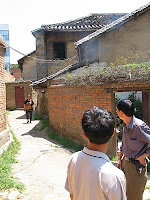Natu Tours the Garden
Monday, May 26, 2008
From six thousand miles away, Vera asked for pictures of my garden. Vera is majoring in Quality and Safety of Food, at Shandong Normal University, in Jinan. We have been IM’ing about fruits and vegetables. Fortunately, my grandson was visiting to help me give the tour.
We started in my sun room. The tank holds Piume, the water turtle. The white pots have sweet granadilla seedlings. The black pot has a young Yellow Pitaya (Hylocereus megalanthus). Its close cousin, the Red Pitaya (dragonfruit Hylocereus undatus), can be seen at the very back of the room. Neither the pitaya nor the dragonfruit has ever blossomed or fruited for me.Avocados are not common in China. Vera once saw some in a supermarket. “They said they came from the USA, so the price was extremely high.” I have two small avocado trees. This year, for the first time, I have about 15 small fruit, which will probably ripen in late fall.The big tree at the left is a Fuyu persimmon. It gives me a large crop every year. I love to eat them fresh, and dried, they are like candy. The little tree is a Babcock peach, new this year. Behind it is a prickly pear cactus. At my feet are potato plants. In the next week or two, Nathanael will graduate from being a baby to being a big brother. That’s his mother in the center.The tree is a tangerine. I get a heavy crop every year. What I can’t eat fresh, I peel and freeze, to eat like popsicles the rest of the year. The red flowers are roses, and the light green leaves are melons I call dinya, which is the generic name for melon in Russian. I found these in Uzbekistan, but they are similar if not identical to the Hami melon I saw in China (哈蜜瓜, but more oblong, and whiter flesh than a canteloup).These grapes are Thompson seedless, and will be ripe in July. My bilingual grandson calls them uvas, which is the Portuguese word. I also have two varieties of red seedless grapes. Behind Nathanael are Italian Honey Figs (Lattarula). They give a short crop in June, and then, after a few weeks, a longer, second crop that lasts until the cold weather hits. I dry them, freeze them, and eat them fresh.The red flowers are pomegranates, and will be ripe in November. The purple flowers are artichokes. By the time they bloom, it is too late to eat them. We ate some, but the flower is so beautiful we like to leave some to feast our eyes on.Ooh, the apricots should be ready to harvest in a couple of weeks.Vera tells me the most Vitamin-C rich fruit is the kiwi. My kiwi vines are two years old. I hope to have fruit next year.I enjoy keeping my garden full of growing things.0 comments:
Subscribe to:
Post Comments (Atom)














